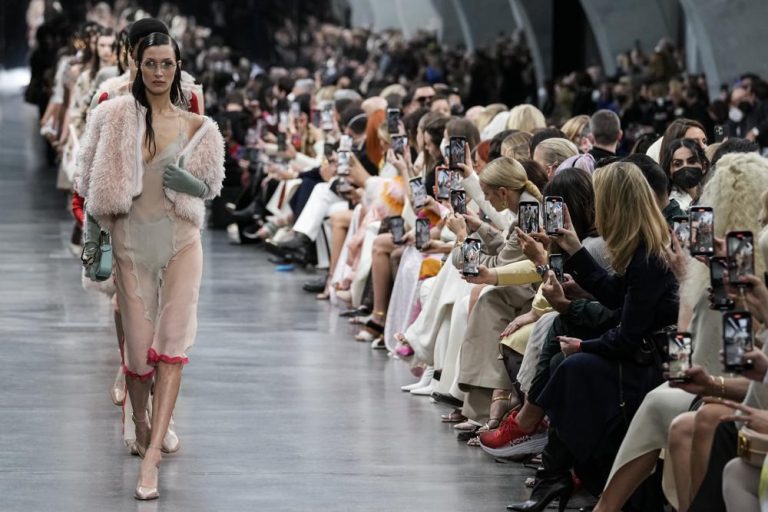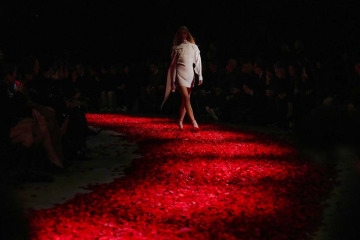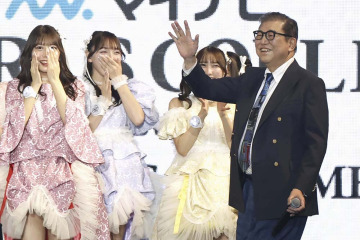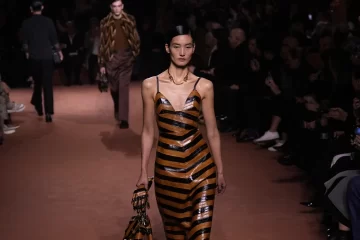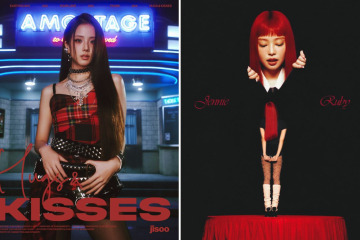Milan, Feb 24, 2022 — As Europe braced for winds from a possible war in Ukraine, the Italian fashion world carried on with a Milan Fashion Week that brought the return of Russian buyers after two years and the easing of pandemic travel restrictions.
An agreement with the government brokered by the Italian National Fashion Chamber allowed Russians who were vaccinated with the Sputnik V shot to enter the country if they were traveling for business and submitted to frequent rapid tests for the coronavirus.
They arrived for the first day of shows Wednesday as tensions built over Russia’s military intensions in Ukraine. Show invitations also were extended to Ukrainian buyers, but they did not attend, according to the fashion council.
Highlights from the mostly womenswear runway shows for next fall and winter:
FENDI MELDS CHIFFON WITH TWEEDS
Creative director Kim Jones packed the Fendi front row with VIPs who included Rita Ora and her partner, Oscar-winning screenwriter Taika Waititi, Swedish pop star Neneh Cherry and daughter Mabel, fashion influencers Chiara Ferragni and Leonie Hanne, and many more.
Alongside a long list of Friends of Fendi decked out head-to-toe in the label’s designs, their arrivals offered a parade of Fendi ready-to-wear the likes of which is rarely seen off the runway.
The show before the show included soft intarsia furs, shearling-lined leather shorts with matching jackets, playful minidresses with open backs and long chiffony numbers. Structured heels on a mini-tower of double Fs and bags emblazoned with Fendi in raised golden letters completed the looks shown on this double runway.
Jones’ latest collection for Fendi interplayed chiffon sheers with tweeds, giving a playful edge to daytime and imbuing evening with a fresh sexiness. Jones said he took inspiration from two collections by the late Karl Lagerfeld that on the surface appear diametrically opposed: Spring-Summer 1986, which featured geometric prints and tailoring, and the sheer lightness of Autumn-Winter 2000.
For Fendi’s Autumn-Winter 2022 collection signed by Jones, chiffons were patchworked together with a ruffled exterior stitch into day dresses with matching bloomers, worn with cropped fur, or ruffle-edge tops with pants. Bright gloves or bags in orange, and grounded by seafoam green, offset the pastel tones.
Black-and-white check trousers and a pencil skirt offered the first hint of structure, paired with chiffon tops and enveloped in a cloud of fur. The looks became more regimented with tight corsets worn over men’s shirts with feminine gathers.
Add-ons like big, belted flat pockets added a utilitarian flair that worked over chiffon dresses in conjunction with the corsets or as an embellishment to a skirt or trouser. As the color palette darkened into navy, brown and gray, Jones offered the same silhouettes in leather, tweed and denim. Some were softened with a chiffon ruffle detail along the seam.
Silvia Venturini Fendi designed the accessories, including three editions of the Fendi Baguette – in cashmere, shearling-lined leather and intarsia mink – to mark the bag’s 25th anniversary. Her daughter, Delfina Delettrez, designed the jewelry, including supersized monogrammed ear cuffs.
“It’s a wardrobe designed for every aspect of a woman’s life, for every generation,” Jones said.
CAVALLI SEDUCING THE GENERATIONS
From J-Lo to Zendaya, Fausto Puglisi wants to unite generations of alluring, strong women through his new collection for Roberto Cavalli.
Puglisi’s first winter runway show as creative director of the brand brought together diaphanous gowns with leather straps that gave a hint of bondage, along with younger silhouettes, including manifold skinsuits in black and animal prints, and as well as playful, bouncy pleated plaid miniskirts.
“I want to respect the heritage of Roberto. That was extraordinary,” Puglisi told reporters. “Never before has there been such a desire to return to the early 2000s. At the same time, there is the desire to move forward.”
Puglisi did so with an accent on daywear that included suits in bright Kelly green British plaid, worn eccentrically with green animal print tights and gloves. Capes in the brand’s trademark animal prints that were cinched in the front, with fringe trailing along the runway. Handcrafted leather florets that graced shoes and dresses were inspired by Capodimonte porcelain.
“We are coming out of a very sad period of isolation, and this woman wants to have fun,” Puglisi added.
SEEKING SPONTANEITY AT No. 21
Alessandro Dell’Acqua’s collection for next season provides seamless transitions from womenswear to menswear, showing just how linked they are at his No. 21 label.
The women’s silhouette is define by the corset shape, which tightens the waist, giving shape to jackets and overcoats, as well as dresses and knitwear. Skirts were seemingly made out of men’s trousers sans inseam, creating a pair of zip-modulated sexy slits. Asymmetrical, bias-cut dresses with a declination of sequins from small to large, were part of the designer’s exploration of old fashion codes, he said in show notes.
Sheer unisex mohair sweaters pulled with an upward drawstring for better definition, for him or her.
A unique piece, an upcycled fur coat got new life with a black tulle overlay for him. Men’s overcoats were otherwise oversized and military in cut; and long thick-pleated skirts substituted for trousers, worn with a Hawaiian print shirt with couture detailing.
“What I cared about most was updating the language in order to obtain female and male figures that best reflect the times, which while imprecise are still forming,″ Dell’Acqua said in notes.
WE ARE MADE IN ITALY
The second class of the We are Made in Italy campaign to promote designers of color who live and work in Italy showed their winter collections next to iconic examples of Italian design in the ADI Design museum.
Fallylah Nyny Ryke Goungou imbued her Nyny Ryke brand with a burst of color, combining west African woven textiles from her native Togo with sexy mesh and yarn macrame accents for looks that suit any Gen-Z and Millennials alike. “I have been really explosive this year!” Goungou exclaimed at her stand near a red Ferrari.
Moroccan-born Zineb Hazim created everyday abayas for the modest but assertive Muslim woman who wants to be covered but still show style and be seen. Sheetal Shah’s unisex look for her Curious Grid label included jackets made from handwoven fabrics sourced in her native India and employing a quilting technique with recycled wool. Romy Calzado’s fitted dress of patchwork jersey had a soft camouflage vibe brought to life with strong shoulders. Judith Borsetto created for her Saint Jermain label boots with a long pointed toe to recall the famous Plague Doctor Venetian mask set off by her trademark embroidery details.
“These five incredible women designers have grown so much,” said Michelle Ngonmo, one of the creative forces behind the campaign and the founder of Afro Fashion Week Milan. “I think it is a good start and that the fashion industry in Italy is really starting to see that POC (people of color) creativity is part of the Italian fashion industry.”
CAPASA COLLECTION ZERO
Ennio Capasa took the fashion crowd backstage, behind the ermine curtain of the Arcimboldi Theater for Collection 0 of his new fashion venture bearing his family name.
Capasa, whose brother Carlo is the president of Milan’s fashion council, is well-known in fashion circles for his influential Costume National brand, which he abandoned six years ago as financial partnerships went awry. Even Gucci CEO Marco Bizzarri showed up for a front row seat at Capasa’s runway return.
“Intervals are an incredible luxury because they afford the distance to observe what you want to keep, what you want to leave,” Capasa said before the show as models received their finishing touches nearby. “I understood that I wanted to keep the timeless tailoring. Many of my friends call to say, ‘Your jackets are still very modern.’ And I wanted to keep that. But I left some of the rigidity that belonged to that time, to the 1990s.”
While his former brand had a uniform quality, strong on deconstructed tailoring in black and white, Capasa said he wanted the Capasa brand to recognize the drastically changed times by creating more individualistic looks.
The collection included looks such as a mini double-breasted pea coat to appeal to members of Gen Z as well as Gen-Xers and beyond. Overcoats featured a striking leather strap and buckle cinched diagonally at chest level.
The collection was strongly influenced by 1970s music, from rock to disco. It featured David Bowie-style suits with broad shoulders, androgynous tunics and wrap dresses that had a faint disco vibe, especially when paired with silver boots. Capasa used a touch more color- there were purple suits, details in mustard yellow and bright Kelly green – than he did during his Costume National days,
The line between menswear and womenswear was fluid. The jewelry reflected the sort of individuality seen on the street, none the same, and each just a bit off-kilter, including body chains or applied crystals instead of tops, and earrings that stuck out like ledges with softly reverberating silver fringe. – AP


